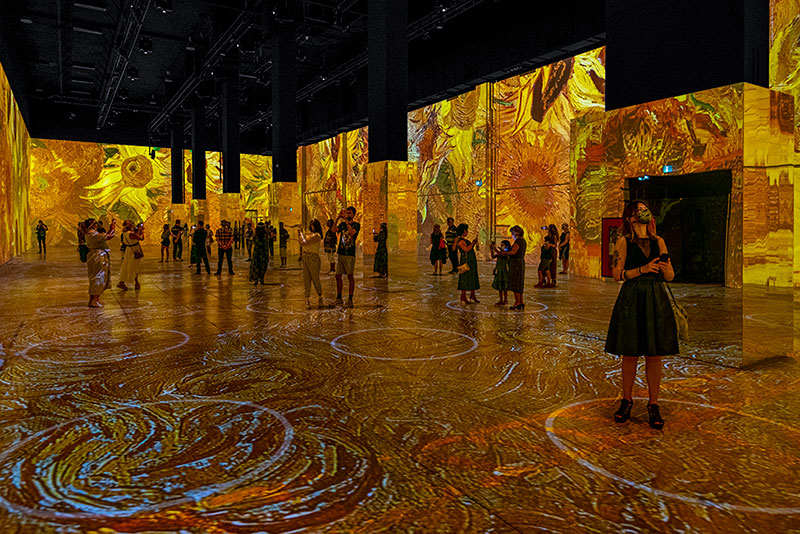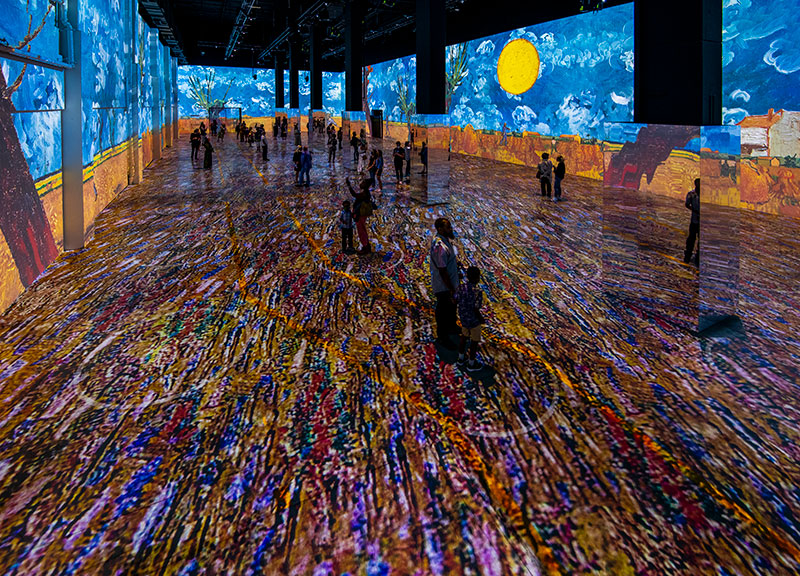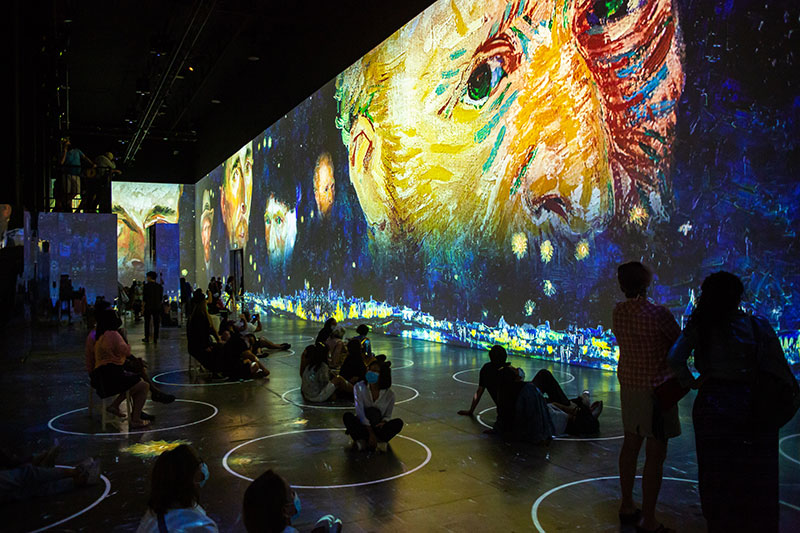A New Art Space Creates a Contemporary Story Line for Van Gogh's Familiar Art

By Ginny Van Alyea
Capping off nearly a year where all art spaces and institutions have been closed to the public at some point, a new arts venue has opened in Chicago. As in, a new space is opening for the first time, in person. To people. If you'd asked me almost a year ago about new spaces ever opening, I am not sure I would have predicted this.
Lighthouse ArtSpace Chicago, housed within the city's recently renovated, landmark Germania Club Building at the intersection of Clark and North Ave., spans three-stories and will be dedicated to immersive art presentations, a welcome effort after a year spent mostly online and definitely not immersed in much.
The space's first presentation, Immersive Van Gogh, launches February 11 and is inspired by the Dutch painter, one of the world's most famous artists. During Van Gogh's short life he painted more than 2,000 artworks ranging from ordinary household items and self-portraits to surreal landscapes, with reproductions gracing millions of college dorm room walls decades later. Immersive Van Gogh offers original artworks in an innovative form and it opens in Chicago at a time when there is likely to be a significant, pent up demand from the general public for this kind of in-person experience. Since tickets went on sale, the Chicago show was tracked as the bestselling show in the world on TicketMaster. It's worth noting that not so long ago, in 2016, the Art Institute of Chicago used Van Gogh's painting of his own bedroom in Arles, France as inspiration for another kind of immersive exhibit – Airbnb even recreated the bedroom and rented it out.
Van Gogh was a post-Impressionist painter whose work — notable for its beauty, emotion and color — highly influenced expressionism in 20th-century art. He struggled with mental illness and remained poor and virtually unknown throughout his life. He was tragically admitted to a psychiatric hospital after offering his severed ear to a woman at a local brothel. For hope, he turned to painting and nature, until one day when he went out to paint in the morning with a loaded pistol in his hand and reportedly shot himself in the chest. In his 37 years alive, Van Gogh only sold one painting, The Red Vineyards, to his brother Theo.

*
Van Gogh's art is arguably a cultural gateway for many people who first admire his accessible, yet sometimes mysterious, images in high school and college art classes. To bring Van Gogh's familiar art to life in new ways, an Italian creative team who pioneered digital experiences in Paris has created a custom design to fit the Neo-Classical architecture of Immersive Van Gogh.
Immersive Van Gogh, comes to Chicago following its debut in Toronto. It has been described as a digital art exhibition that invites audiences to “step inside” van Gogh's iconic works, evoking his highly emotional and chaotic inner consciousness through art, light, music, movement and imagination, merging the boundaries between entertainment and culture with the hope of exposing the public to art in an entirely new way. Utilizing the Germania Club building's Victorian Era architectural details, 35-foot-tall walls and multiple levels (including balconies), the venue will present vibrant immersive art exhibitions that surround the viewer on all sides long after the Van Gogh run is finished.
With more than 50 projectors illuminating over 14,000 square-feet, visitors to Immersive Van Gogh will be encircled from head-to-toe in Van Gogh’s brushstrokes and colors, including animated details from works such as Self Portrait with Felt Hat (1888), The Bedroom in Arles (1889), Irises (1889) and The Starry Night (1889).
“Immersive Van Gogh is a new way of encountering art, as it quite literally surrounds viewers on all sides with the brilliant work of one of the greatest painters of all time,” said Immersive Art Space Co-Producer Corey Ross. “Both connoisseurs and new admirers of Van Gogh’s work are guaranteed a breathtaking perspective on the influential artist’s oeuvre.”
The exhibition was designed by creative director and Italian film producer Massimiliano Siccardi, with original music by Italian multimedia composer Luca Longobardi, who provided a score that combines experimental electronic music with pure, ethereal piano. Vittorio Guidotti is the Art Director. Siccardi and Longobardi are both pioneers of immersive digital art experiences in Paris, where they were part of the team that created the world-renowned Van Gogh, Starry Night exhibition, among others.
Siccardi has a decades-long history of experimenting with “digitally immersive” art, beginning with exhibitions at the Cathédrale d’Images in Baux-de-Provence, France. A former quarry, the Cathédrale d’Images was used as a venue for art exhibitions as early as the 1970s, when artist and journalist Albert Plécy created illuminated “frescoes” by projecting from dozens of carousel projectors onto the white limestone walls of the disused quarry. The projections covered the contours of the walls and the ceilings of the quarry, and were also accompanied by a soundtrack and actors. Siccardi cites Plécy’s work as a starting point, from which he was inspired to create dozens of immersive exhibitions in the space and then later in other venues around the world. Vincent van Gogh in particular is a subject of fascination and obsession for Siccardi, and Immersive Van Gogh is an exploration of the master artist’s human experience up until the moment of death.
“In my view, we create a work based on a great artist’s work. For this reason, I believe that our transposition allows a wider audience to get closer to art, and I sincerely hope to intrigue people to the point that they want to go and enjoy art in museums, to view the original paintings in their truest form and might. Therefore, we do not replace the author's work but we give a possible reading of it; we respectfully tell an emotionally engaging part of it, and we are always aware that we are freely reinterpreting it.”

When I asked about how the exhibition came together, Maestro Immersive Arts co-founder and Lighthouse Immersive partner Maria Shclover explained, "This particular way of projecting is a sort of slicing of images – through visual strokes, animation and media – level by level to construct the picture and allow you to go into the mind of Van Gogh. It is inspired by Van Gogh but made possible by these contemporary artists. They put it together."
Over the course of an hour Shclover says visitors will go on a journey. "It's accompanied by music, and there is a story line, but you can start at any point."
To make the experience safe for today's viewing, the walk-through experience has been designed with health and safety as a priority. Capacity will be limited in accordance with the City of Chicago’s safety protocols. Additional safety precautions include touchless ticket-taking, temperature checks upon arrival, hand sanitizer stations, social distancing markers throughout the venue, and digitally projected social distancing circles on the gallery floors to ensure appropriate spacing. All guests must wear a face covering at all times during their visit to Lighthouse ArtSpace Chicago.
For more information about Immersive Van Gogh and to buy tickets, visit vangoghchicago.com. Ticket prices start at $39.99 for adults ($24.99 for children 16 or younger) with untimed and flexible ticket options available.
The exhibition runs from Feb. 11 through Sept. 6, 2021.